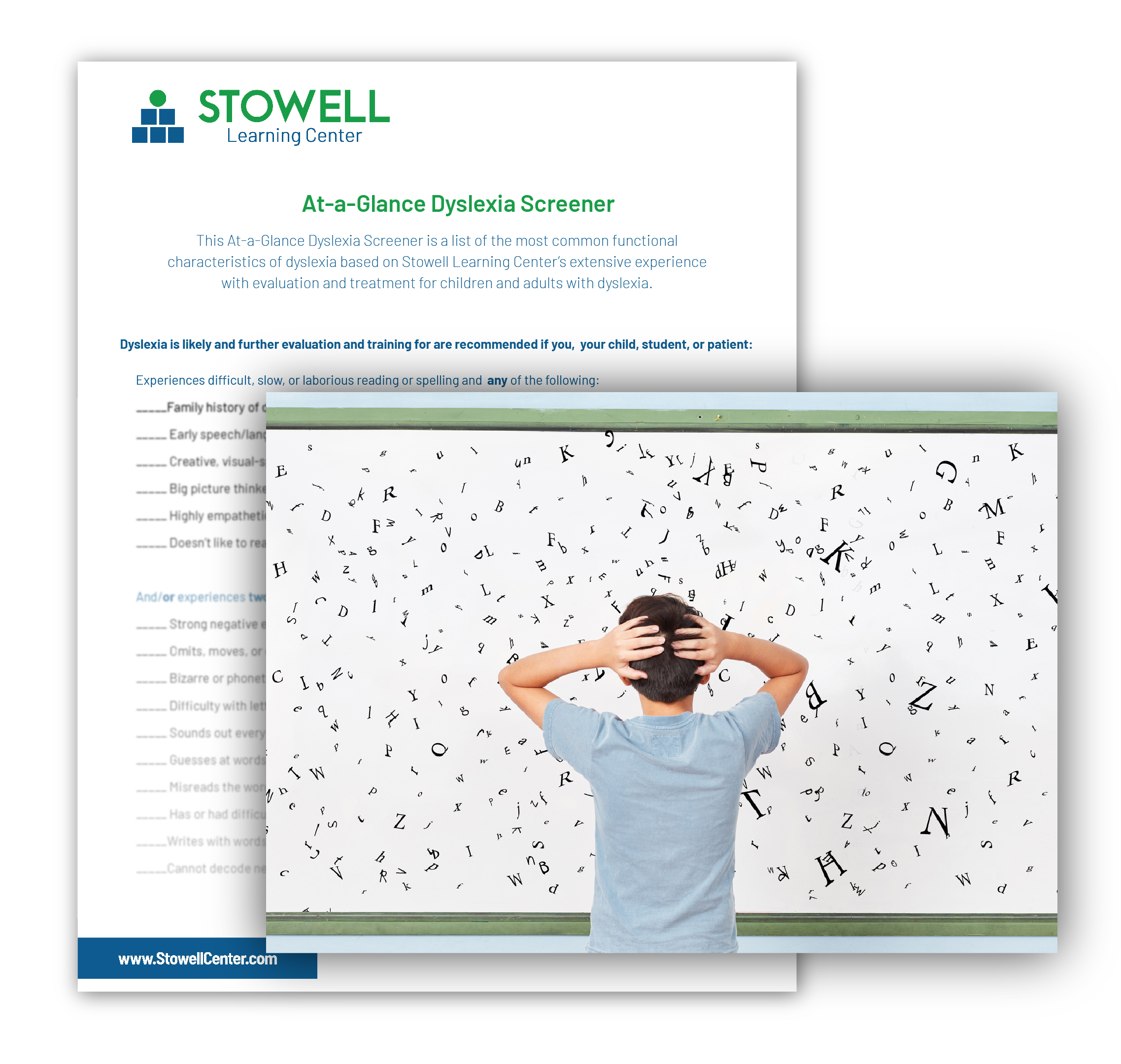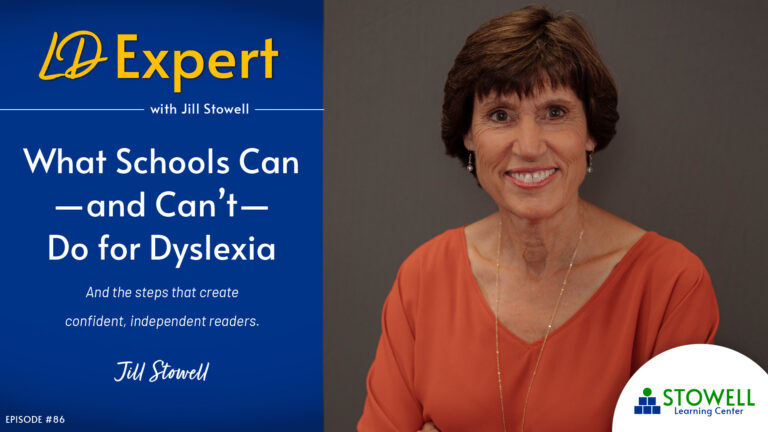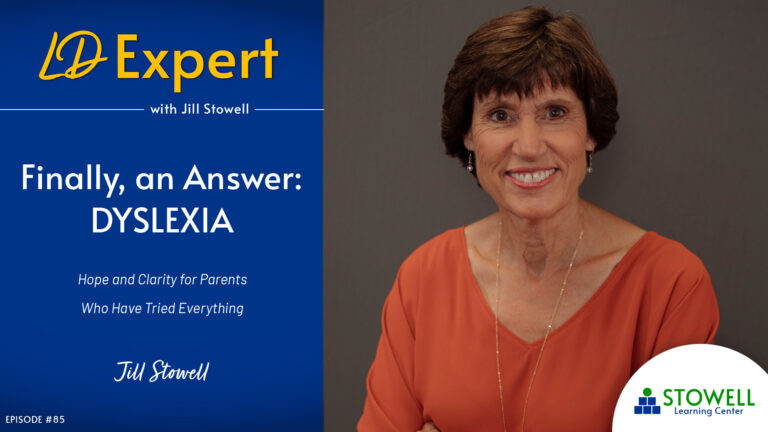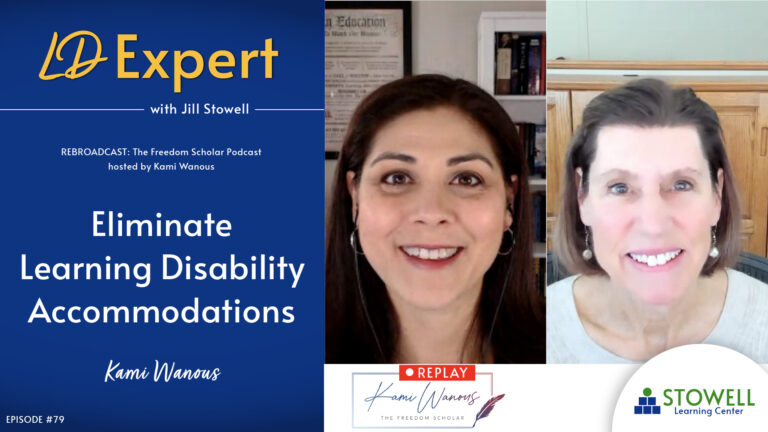DEFINITION
What is Dyslexia and What are the Symptoms?
The formal definition of dyslexia according to the International Dyslexia Association is:
“Dyslexia is a specific learning disability that is neurobiological in origin. It is characterized by difficulties with accurate and/or fluent word recognition and by poor spelling and decoding abilities. These difficulties typically result from a deficit in the phonological component of language that is often unexpected in relation to other cognitive abilities and the provision of effective classroom instruction. Secondary consequences may include problems in reading comprehension and reduced reading experience that can impede growth of vocabulary and background knowledge.”
What is Dyslexia According to Stowell Learning Centers?
We agree with the definition provided by the International Dyslexia Association.
Practically speaking, adults and children with dyslexia will have difficulty retaining an accurate image of words, thinking about the sounds and sound groupings in words (phonological awareness), and even sounding out words (decoding). People with dyslexia may also have visual disorientation when looking at print or symbols on a 2-dimensional plane.
Dyslexia has both visual and auditory components with varying degrees of severity. According to our Learning Skills Continuum, dyslexia challenges are highly associated with weaknesses in some or all of the following processing skills:
- Phonemic awareness
- Phonological awareness
- Neuro-timing deficits that cause visual confusion and disorientation on the page
- Auditory memory span
- Visual memory span
- Sequential processing
- Processing speed for aspects of language
- Bilateral integration / Ability to cross the body’s vertical midline
Adults and children with dyslexia are often bright, big-picture thinkers with good comprehension and strong visual-spatial abilities that lend themselves to the arts, creative problem solving, and out-of-the-box thinking.
Educational Challenges Related to Dyslexia
Educational challenges in dyslexia can show in a student’s reading, spelling, writing, speech and/or motor skills, but remember, each person with dyslexia is different. Not all people with dyslexia will exhibit all of these symptoms.
Reading difficulties related to dyslexia:
- Doesn’t recognize a word that has literally just been read
- Skips a line in a paragraph or loses place while reading
- Lack of fluency or lack of expression while reading
- Omits, moves, or confuses small common sight words such as the, of, and if when reading
- Bizarre or phonetic spelling; Can memorize spelling words for test but can't retain
- Difficulty with letter sounds: remembering, discriminating, or blending
- Sounds out every word; doesn't recognize words just read when seen again on the page
- Guesses at words based on a few letters in the word
- Misreads the word but gets the meaning (i.e. reads cat for kitten or physician for doctor).
- Writes with words they can spell; oral expression much stronger than written
- Cannot decode new words; dependent on their fund of memorized words
- Great difficulty with word problems
Speech challenges related to dyslexia:
- Mispronounces words
- Gets words out of order
- Difficulty finding the word they want to say
- Confuse words that sound similar: silt/silk
Writing challenges related to dyslexia:
- Inconsistent: spells a word multiple ways in a single piece of writing
- Missing or misplaced punctuation marks.
- Impaired letter writing where writing is extremely messy or illegible, with poorly formed letters and reversed letters
- Poorly spaced words
- Misaligned lines of writing
- Doesn’t show a dominant hand preference until primary/elementary school
- Ambidextrous
- Holds pen/pencil in an unusual way
- Has trouble copying information from the board
- Draws letters versus writing automatically
Motor skill challenges related to dyslexia:
- Confusion with spatial orientation such as right and left, above and below, over and under, etc.
Dyslexia Screener
A list of the most common functional characteristics of dyslexia based on Stowell Learning Center's extensive experience with evaluation and treatment for children and adults with dyslexia.
Subscribe to our newsletter to download this guide, and get access to all of our downloadable resources.
TESTING FOR DYSLEXIA
Functional Academic and Learning Skills Evaluation
A comprehensive Functional Academic and Learning Skills Evaluation (Functional Evaluation, for short) was created at Stowell Learning Centers to screen for dyslexia and any other co-existing learning disability.
Dyslexia is a total thinking style, so in the Functional Evaluation, we screen for more than language and reading skills. Parent and student input regarding family history, strengths and challenges is very important along with formal and informal testing. We do a careful analysis of the types of errors the student makes, and observation of what reading and writing looks like for that particular student.
Here are key factors to evaluate in determining if a student is dyslexic and the best avenue for treatment:
- Is there a family history of dyslexia?
- What are the person’s talents or abilities?
- Are there retained or unintegrated reflexes that are interfering with visual skills, attention, and crossing the midline of the body?
- Auditory processing including discrimination of sounds, memory, auditory attention, stamina, and ear dominance for language
- Visual processing and memory for letters, sequences of symbols, and words
- Visual processing and visualization of non-symbolic information / 3D thinking
- Phonetic decoding, sight words, reading fluency
- Difficulty learning or writing the alphabet
- Reading comprehension versus listening comprehension
- How does the student approach unfamiliar words?
- Symptoms of disorientation or neuro timing deficits when reading or writing
- Omit, add, substitute, repeat, or switch sounds or words
- Spelling
How Is Dyslexia Testing Different At Stowell Learning Centers?
Some eye doctors and vision therapists diagnose dyslexia and look at the reflexes and visual skills connected with reading. School psychologists or educational psychologists may provide information about the thinking skills that make up intelligence as well as reading skills in order to determine a diagnosis.
What’s missing is a real understanding of how that student is approaching reading, what compensations they are using, what underdeveloped or underused processing skills are really at the root of the challenges, and what to do about it.
The dyslexic thinking style is more than reading difficulties. In fact, many people with dyslexia can read, though it may be slow and inefficient. Dyslexic students tend to use their strengths to compensate, sometimes causing their dyslexia to get missed.
In order to truly address the underlying skills at the root of the challenges, a functional evaluation is needed to look at all different aspects of the dyslexic thinking style, what skills underneath reading are keeping the dyslexic brain from getting the information needed to read accurately and fluently.
The purpose of the functional evaluation is to understand the student’s particular dyslexic profile in order to create a targeted plan to address the weak underlying skills and the most effective programming for remediating the reading, writing, and spelling difficulties.
What Are the Different Types of Dyslexia?
There are three primary types of dyslexia and four combination types:
- Dysnemkinesia (difficulty remembering and writing letter symbols without reversals)
- Dysphonesia (difficulty connecting sound and symbol in order to use phonics for reading and spelling)
- Dyseidesia (difficulty visually recognizing whole words for reading and recalling the visual image for spelling)
- Dysphoneidesia (difficulty connecting sound and symbol in order to use phonics for reading and spelling and difficulty visually recognizing whole words for reading and recalling the visual image for spelling)
- Dysnemkinphonesia (difficulty remembering and writing letter symbols without reversals and difficulty connecting sound and symbol in order to use phonics for reading and spelling)
- Dysnemkineidesia (difficulty remembering and writing letter symbols without reversals and difficulty visually recognizing whole words for reading and recalling the visual image for spelling)
- Dysnemkinphoneidesia (difficulty remembering and writing letter symbols without reversals, difficulty connecting sound and symbol in order to use phonics for reading and spelling, and difficulty visually recognizing whole words for reading and recalling the visual image for spelling)
Is Stowell Learning Center Able to Test for All Types of Dyslexia?
At Stowell Learning Center, we test for all seven types of dyslexia and explore the various aspects of reading, as well as the processing skills that are frequently associated with dyslexia:
- Auditory processing
- Visual processing
- Phonemic awareness
- Neuro timing
- Memory
- Attention
- Processing speed
Do I Need an Official Diagnosis of Dyslexia, or Can Stowell Learning Center Provide One?
We do not need an official diagnosis in order to create a treatment plan. Many of our students come to us with undiagnosed learning disabilities.
While we can provide a diagnosis of dyslexia, our goal is not to diagnose or qualify students for special services, but rather to determine the root cause of the struggles with learning or attention parents are reporting to us.
The prevalence of dyslexia is about 1 in 5 people so many students may be unaware and undiagnosed. It is possible for someone with dyslexia to not pass dyslexia evaluations due to the way the testing is conducted, or how well a student’s coping mechanisms mask their dyslexia.
Regardless of an official diagnosis, our Functional Evaluation enables us to pinpoint weak underlying processing skills that can be strengthened to boost learning.
TREATMENT
Can Dyslexia Be Corrected?
It is commonly believed that dyslexia is a life-long struggle, to be coped with but never to be corrected. Neuroscience research proves that through targeted and intensive cognitive training, the brain can rewire itself to learn to process information more effectively. Most diagnosed and undiagnosed learning disabilities including dyslexia can be permanently corrected by identifying and developing the weak underlying learning/processing skills that are at the root of the problem. Correcting these underlying weaknesses will not take away the brilliant thinking style that our dyslexic learners have. It will just allow them to quit feeling stupid about school.
Lazy, unmotivated, or “doesn’t care” are myths that are all too often believed about students with dyslexia and learning disabilities. If you keep trying hard and it’s not making a difference, you may eventually give up or quit trying, but kids do not want to fail, and in our experience, our struggling students typically put out far more mental effort and energy than their peers to get the job done.
Accommodations
A word about accommodations: Accommodations are a good thing on a temporary basis, but the belief that students with dyslexia will just need to manage by forever using accommodations is unfair and untrue. While alternate ways of teaching and testing help students be more comfortable in school, they don’t address the underlying issues that are causing the problem. If the school is offering accommodation and supports, by all means make use of them while the real problem is being corrected, but don’t think of them as a permanent solution.
Dyslexia Accommodations Guide
Classroom accommodations and modifications as a temporary support for your dyslexic learner.
Subscribe to our newsletter to download this guide, and get access to all of our downloadable resources.
What Aspects of Dyslexia Can Be Corrected?
In our experience over the last 40 years, the reading, writing, spelling, and speaking challenges associated with dyslexia can be eliminated. Through auditory stimulation and training, the brain can learn to pay attention to and process the wide range of sound frequencies needed in order to improve phonemic and phonological awareness and subsequently speech articulation, verbal clarity, decoding, reading, and spelling.
Addressing Neuro Timing, Visual Processing, and Speed
Neuro timing, disorientation, visual processing, and processing speed can be addressed in a number of ways to increase processing speed, reading fluency, stamina, and visual stability with symbols and words on the page, decreasing letter confusion and reversals and increasing automatic word recognition.
Changing Brain Pathways for Reading
Brain imaging studies show that dyslexic readers tend to use less efficient pathways in the brain for reading than skilled readers, over-utilizing Broca’s area (responsible for saying the sounds) and the right hemisphere (which does not process phonics and language well). Research also shows that through targeted training, the brain can develop new, more effective neuropathways. Dyslexic learners do not have to be stuck with sound-by-sound decoding and slow, laborious reading.
Improving Reading Comprehension and Confidence
Reading comprehension, speed, enjoyment of reading, and confidence improve as the critical underlying skills for reading are developed.
Dyslexic Students Can Thrive
Dyslexic students are bright and capable. While the length of treatment varies depending upon the number and severity of issues, our goal for them when they finish is that they will read and write comfortably and independently, thrive in their regular classes at school, and have the skills and confidence to pursue their postsecondary dreams.
Having specialized in eliminating the challenges associated with dyslexia and learning disabilities for 40+ years, we have had the opportunity to see this happen for thousands of students!
Cognitive Learning Therapies for Dyslexia
Programs to build key underlying auditory and visual processing skills for reading while developing reading and spelling skills and competency:
- Auditory Stimulation and Training - Reading and Spelling (AST-R/S)
- Easing into Reading
- Discover Reading
Programs to increase memory, processing speed, phonemic awareness, and overall cognitive fluency:
- AMPS (Attention, Memory, and Processing Skills)
- PACE (Processing and Cognitive Enhancement)
- Enhanced Lateralization
Programs/Strategies to decrease disorientation and symbol confusion:
- PATH (Perceptual Attention Therapy)
- Davis Alignment Procedure
- Symbol Mastery
Programs to integrate retained reflexes and increase attention, graphomotor skills, visual processing, and right-left integration:
- Core Learning Skills training (CLS)
- Brain Integration Training



Treatment Plan for Dyslexia
Here’s what a treatment plan for a dyslexic student might look like, but remember, each student’s plan will be a little different because each student comes to us with a different combination of strengths, challenges, and other learning disabilities.
Cognitive Learning Plan Objectives:
- Increase auditory and visual processing, phonemic awareness, memory, concentration, and processing speed.
- Eliminate symbol confusion and decrease visual disorientation when reading and writing.
- Increase decoding, reading, and spelling accuracy and fluency.
Signature Program - Step 1
Programming Recommendations:
- The Listening Program - Level 1 (TLP-Online)
- AMPS (Attention, Memory, and Processing Skills)
- Symbol Mastery
- Davis Alignment Strategy
Recommended number of hours per week: 4.5 hours (1.5 hours one day a week and 1 hour per day, 3 days a week)
Recommended Home follow-up: Daily home listening
Based on the recommended 4.5 hours per week, it is estimated that Step 1 programming will take approximately 5 months to complete.
Signature Program - Step 2
Programming Recommendations:
- The Listening Program- Level One (TLP-Online)
- Auditory Stimulation and Training- Reading, Spelling (AST-R/S) with Enhanced Lateralization
- PATH (Perceptual Attention Therapy)
- Brain Integration Training (BIT)
Recommended number of hours per week: 4.5 hours (1.5 hours per day 3 times per week)
Recommended Home follow-up: Daily home listening
Based on the recommended 4.5 hours per week, it is estimated that Step 2 programming will take approximately 5 months to complete.
What is the Timeframe to See Results?
Most of our students attend 3 - 4.5 hours per week and are with us somewhere between 9 and 24 months. However, students with severe dyslexia or other accompanying challenges may require a longer course of treatment.
Doing an Intensive Program (10 - 20 hours a week for 6 - 8 weeks) is highly effective for our dyslexic students and can condense six to nine months of therapy into six to eight weeks.
ADDITIONAL RESOURCES
Blog
- Are we "Curing" Dyslexia?
- Dyslexia vs. ADHD: Are They The Same?
- Is Your Child's Behavior Masking Dyslexia?
- Breaking the He-Can't-Learn-Phonics-Myth
- Tackling Spelling
- So What Is Dyslexia Anyway?
Books
Research
- AMPS (Attention, Memory, and Processing Skills)
- Auditory Stimulation and Training - Reading and Spelling (AST-R/S)
- Easing into Reading
- Discover Reading
- The ListenIng Program (TLP)
- PACE (Processing and Cognitive Enhancement)
- PATH (Perceptual Attention Therapy)
- Retained Primitive Reflexes & Core Learning Skills
- Symbol Mastery and Davis Reading Correction
Dyslexia Podcast Episodes
READY TO TAKE THE NEXT STEP?
Speak to a Learning Specialist to ask questions and learn how Core Learning Skills training can help.
The call is free and without obligation.












